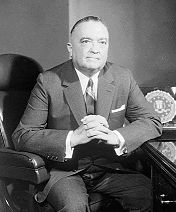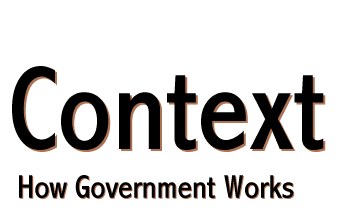


Yet these are the same guys who not only couldn't win the Vietnam War, they couldn't even knock off Castro.

![]() If there was a evil genius among the government officials connected with the assassination, it must have been J. Edgar Hoover, Director of the FBI (at right, in a photo circa 1953). Most conspiracists believe that he, if not actually involved in the assassination, was involved in a cover-up of an assassination conspiracy. But the document trail shows him often to be clueless about key issues. For example, on the afternoon of the assassination, Hoover told Robert Kennedy (1.) that Oswald got into a gunfight with two police officers within a block or two of the Depository, and (2.) that Oswald had been to Cuba "on several occasions." These statements were not merely untrue, they were downright wacky.
If there was a evil genius among the government officials connected with the assassination, it must have been J. Edgar Hoover, Director of the FBI (at right, in a photo circa 1953). Most conspiracists believe that he, if not actually involved in the assassination, was involved in a cover-up of an assassination conspiracy. But the document trail shows him often to be clueless about key issues. For example, on the afternoon of the assassination, Hoover told Robert Kennedy (1.) that Oswald got into a gunfight with two police officers within a block or two of the Depository, and (2.) that Oswald had been to Cuba "on several occasions." These statements were not merely untrue, they were downright wacky.
![]() On the Friday following the assassination, Hoover talked to President Lyndon Johnson via phone, and he was still more than a little confused about key details of the case.
On the Friday following the assassination, Hoover talked to President Lyndon Johnson via phone, and he was still more than a little confused about key details of the case.
![]() Hoover was responsible for the claim that tapes of the voice of the man who visited the Soviet Embassy in Mexico City had been reviewed by Dallas FBI agents who determined that the man was not Oswald. This would be strong evidence of an "Oswald imposter" in Mexico City. But an extensive investigation by the House Select Committee concluded that Hoover was simply wrong about this.
Hoover was responsible for the claim that tapes of the voice of the man who visited the Soviet Embassy in Mexico City had been reviewed by Dallas FBI agents who determined that the man was not Oswald. This would be strong evidence of an "Oswald imposter" in Mexico City. But an extensive investigation by the House Select Committee concluded that Hoover was simply wrong about this.
![]() Hoover's FBI has been involved in more than a few comical episodes. One hilarious example is found in FBI files that record the Bureau's efforts to determine whether a song called "Louie Louie" was obscene.
Hoover's FBI has been involved in more than a few comical episodes. One hilarious example is found in FBI files that record the Bureau's efforts to determine whether a song called "Louie Louie" was obscene.
According to later estimates from CIA officials who worked on the U-2 project and the OXCART (SR-71, or Blackbird) project, over half of all UFO reports from the late 1950s through the 1960s were accounted for by manned reconnaissance flights (namely the U-2) over the United States. This led the Air Force to make misleading and deceptive statements to the public in order to allay public fears and to protect an extraordinarily sensitive national security project. While perhapsjustified, this deception added fuel to the later conspiracy theories and the coverup controversy of the 1970s. The percentage of what the Air Force considered unexplained UFO sightings fell to 5.9 percent in 1955 and to 4 percent in 1956."A Die-Hard Issue: CIA's Role in the Study of UFOs, 1947-90" is on the CIA's own web page.
Government Withholding DocumentsFor the conspiracy-minded, nothing better proves an official plot than the fact that the government has kept secret for over 30 years a mass of documents relating to the assassination. Must be part of a "coverup," right? How does government routinely deal with its documents? Recent issues of The Record - News From the National Archives and Records Administration, show what the government is finally getting around to releasing. For example: The Fish and Wildlife Service just opened a cubic foot of records: "Monthly Statistical Bulletins and Current Fishery Statistics for the ports of Boston and Gloucester, MA, 1901-1944 and Portland, ME, 1915-1944. These reports show species, quantities, and values of fish landed; location of fishing grounds; size and nature of the fishing fleets; number of vessel sailings; and type of fishing gear (trawls, gill nets, etc.)" (Vol 4, No. 3, January 1998, p. 31)And see Vol 4, No. 4, March, 1998: Page 31: "Declassification and Initial Processing Division" for:
When the FBI investigated the claim that the lyrics to the song "Louie, Louie" were obscene (see above) they redacted portions of the key documents. Here is one FBI document with redactions, and here is a similarly redacted FBI report. Of course, the Assassination Records Review Board wound up a massive review and release of assassination documents in the Fall of 1998. So far nothing has been released showing a conspiracy. So what have the conspiratorialists said? "The documents have been sanitized!" But if government can remove all trace of a supposed conspiracy from the documents, that raises the question of why they didn't do that and release the documents 20 or 30 years ago. |
Was the CIA really that effective?
Author Max Holland has discovered several key documents outlining the CIA's reaction to the Garrison probe. The Agency's response to Garrison, however, is rather different from the one claimed by the conspiracists.
Bureaucrats do sometimes conceal information that reveals their own wrongdoing or incompetence. But often they conceal information for no intelligible reason at all.